coolant temperature CHEVROLET BLAZER 1994 2.G Owners Manual
[x] Cancel search | Manufacturer: CHEVROLET, Model Year: 1994, Model line: BLAZER, Model: CHEVROLET BLAZER 1994 2.GPages: 348, PDF Size: 17.88 MB
Page 11 of 348
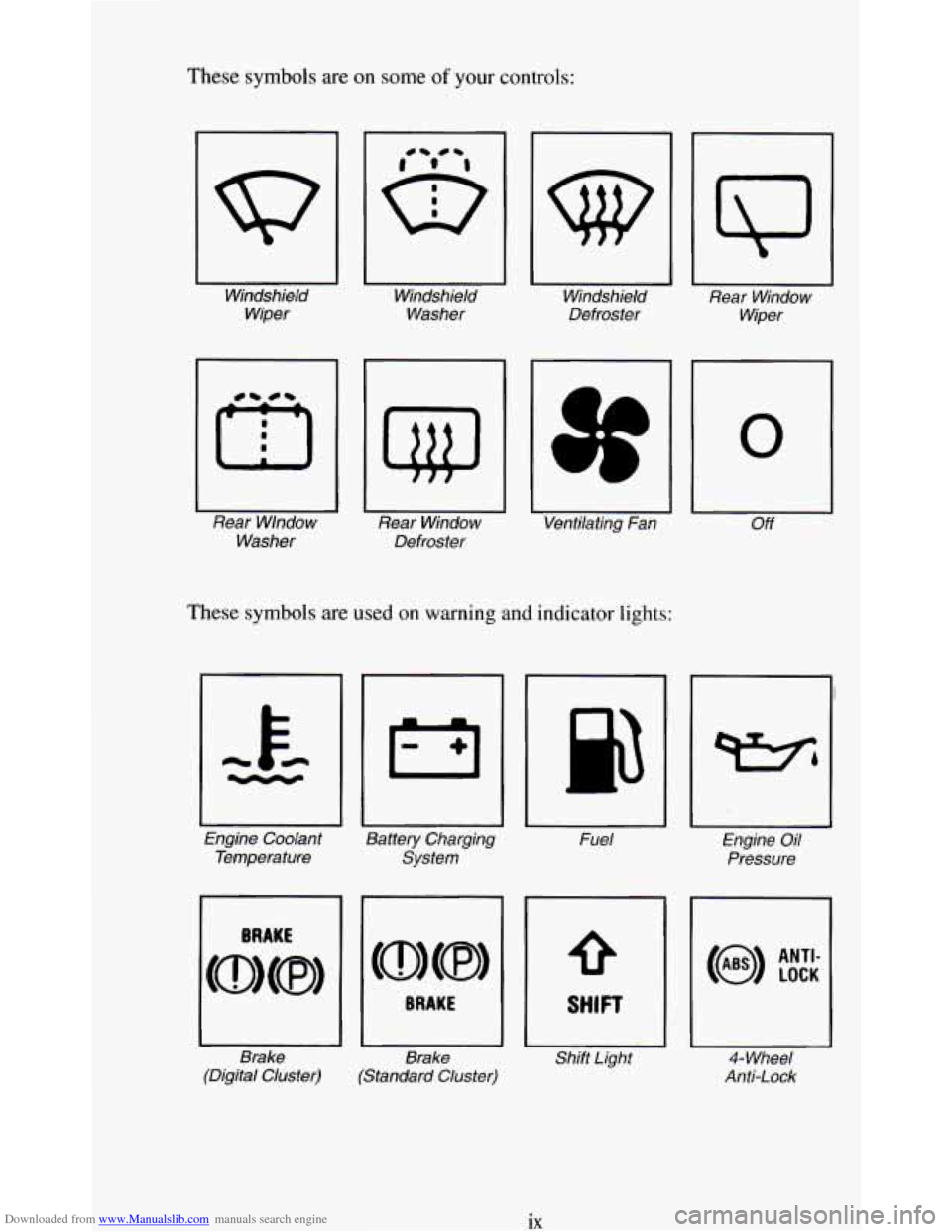
Downloaded from www.Manualslib.com manuals search engine These symbols are on some of your controls:
Windshield Windshield Windshield
Rear Window
Wiper Washer
Defroster
Wiper
Rear Wlndow Rear Window Ventilating Fan
Off
Washer Defroster
These symbols are usea on warning and indicator lights:
0
Engine Coolant
Battery Charging Fuel Engine Oil
Temperature System Pressure
Brake Brake Shift Light
4- Wheel
(Digital Cluster) (Standard Cluster) Anti-Lock
ix
Page 124 of 348
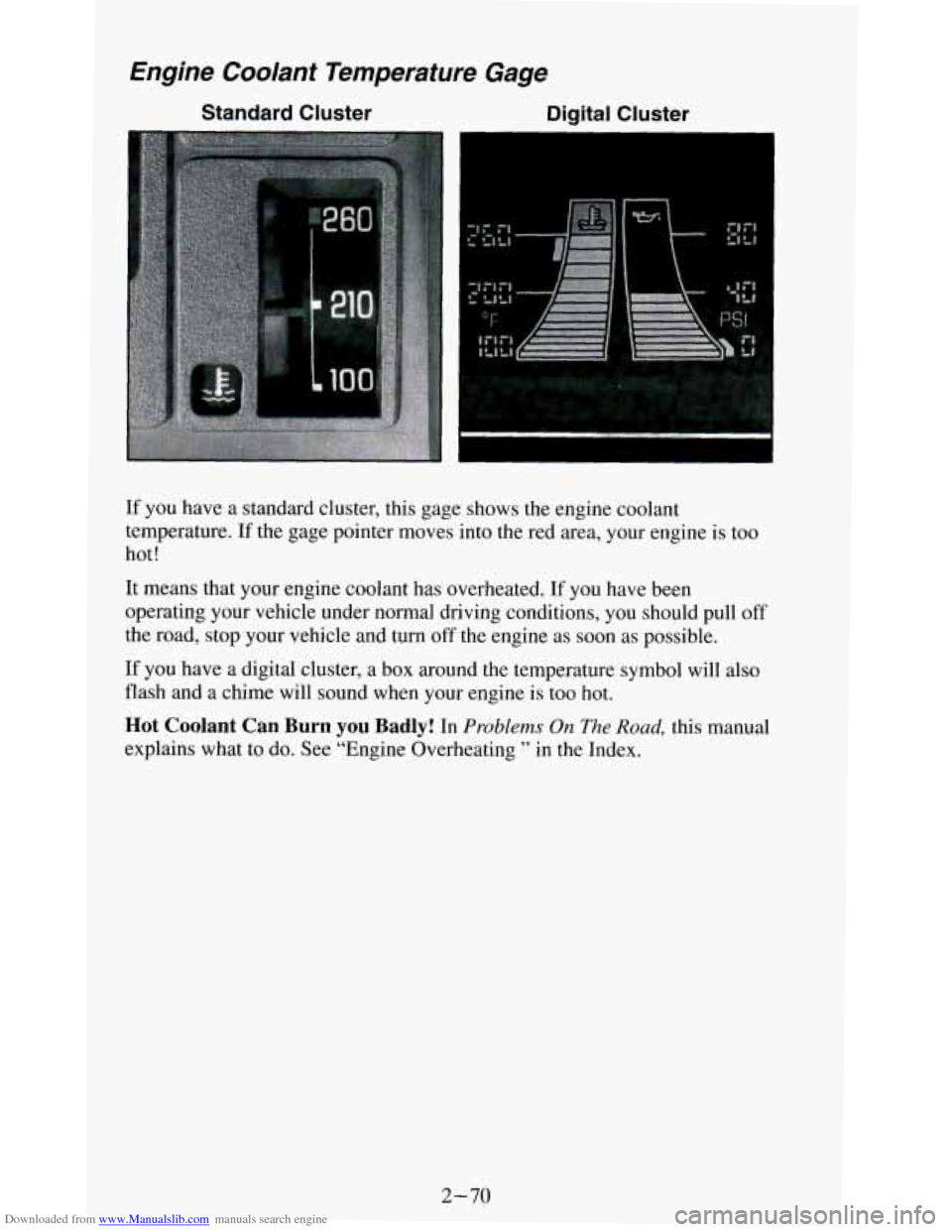
Downloaded from www.Manualslib.com manuals search engine Engine Coolant Temperature Gage
Standard Cluster Digital Cluster
If you have a standard cluster, this gage shows the engine coolant
temperature.
If the gage pointer moves into the red area, your engine is too
hot!
It means that your engine coolant has overheated.
If you have been
operating your vehicle under normal driving conditions, you should pull
off
the road, stop your vehicle and turn off the engine as soon as possible.
If you have a digital cluster, a box around the temperature symbol will also
flash and a chime will sound when your engine is too hot.
Hot Coolant Can Burn you Badly! In Problems On The Road, this manual
explains what to do. See “Engine Overheating
” in the Index.
2-70
Page 139 of 348
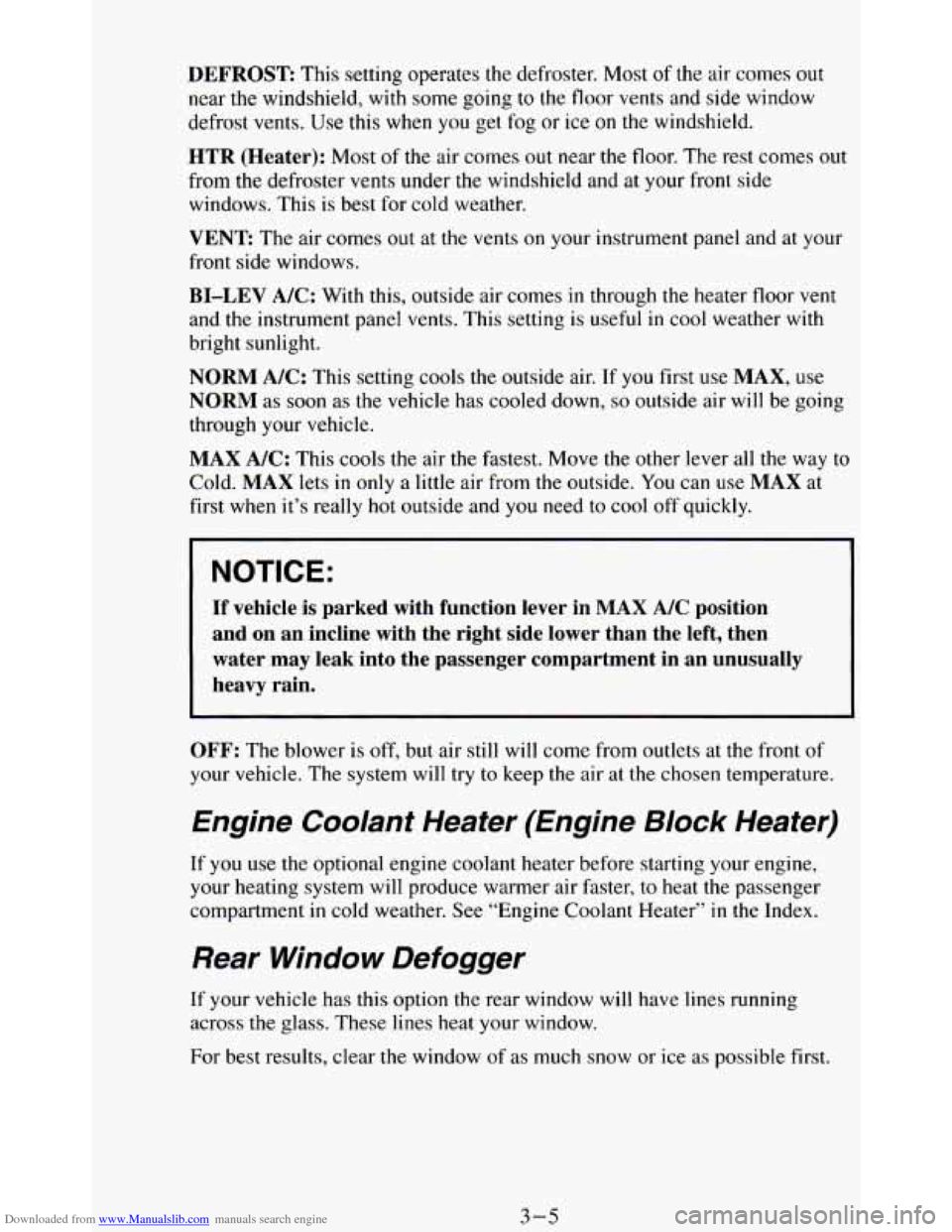
Downloaded from www.Manualslib.com manuals search engine DEFROST This setting operates the defroster. Most of the air comes out
near
the windshield, with some going to the floor vents and side window
defrost vents.
Use this when you get fog or ice on the windshield.
HTR (Heater): Most of the air comes out near the floor. The rest comes out
from the defroster vents under the windshield and at
your front side
windows. This is best for cold weather.
VENT The air comes out at the vents on your instrument panel and at your
front side windows.
BI-LEV A/C: With this, outside air comes in through the heater floor vent
and the instrument panel vents. This setting is useful
in cool weather with
bright sunlight.
NORM A/C: This setting cools the outside air. If you first use MAX, use
NORM as soon as the vehicle has cooled down, so outside air will be going
through your vehicle.
MAX A/C: This cools the air the fastest. Move the other lever all the way to
Cold.
MAX lets in only a little air from the outside. You can use MAX at
first when it’s really hot outside and you need to cool off quickly.
NOTICE:
If vehicle is parked with function lever in MAX A/C position
and on an incline with the right side lower than the left, t\
hen water may leak into the passenger compartment in an unusually
heavy rain.
J
OFF: The blower is off, but air still will come from outlets at the front of
your vehicle. The system
will try to keep the air at the chosen temperature.
Engine Coolant Heater (Engine Block Heater)
If you use the optional engine coolant heater before starting your engine,
your heating system
will produce warmer air faster, to heat the passenger
compartment
in cold weather. See “Engine Coolant Heater” in the Index.
Rear Window Defogger
If your vehicle has this option the rear window will have lines running
across the glass. These lines heat your window.
For best results, clear the window
of as much snow or ice as possible first.
3-5
Page 213 of 348
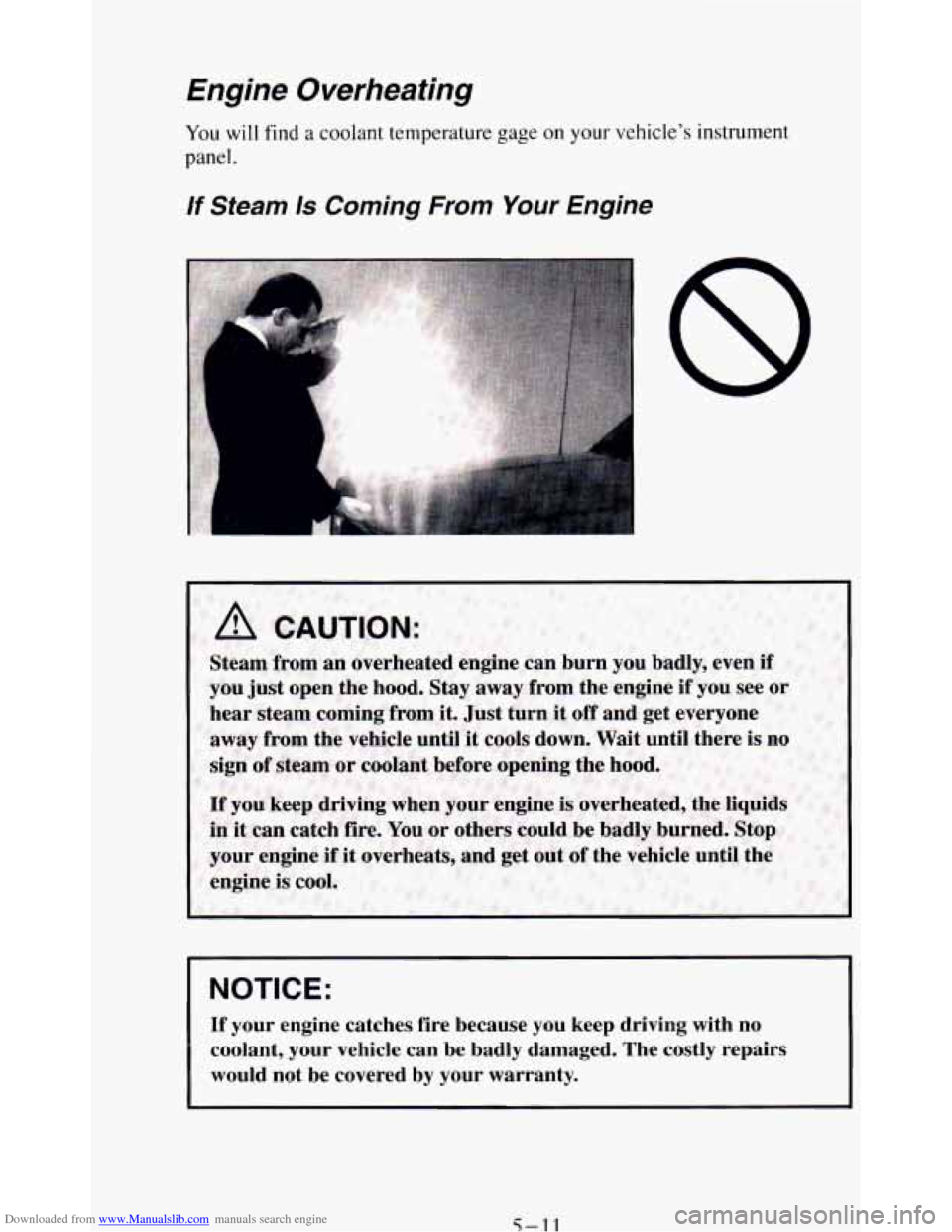
Downloaded from www.Manualslib.com manuals search engine Engine Overheating
You will find a coolant temperature gage on your vehicle's instrument
panel.
lf Steam /s Coming From Your Engine
NOTICE:
If your engine catches fire because you keep driving with no
coolant, your vehicle can be badly damaged. The costly repairs \
would not be covered by your warranty.
5-11
Page 259 of 348
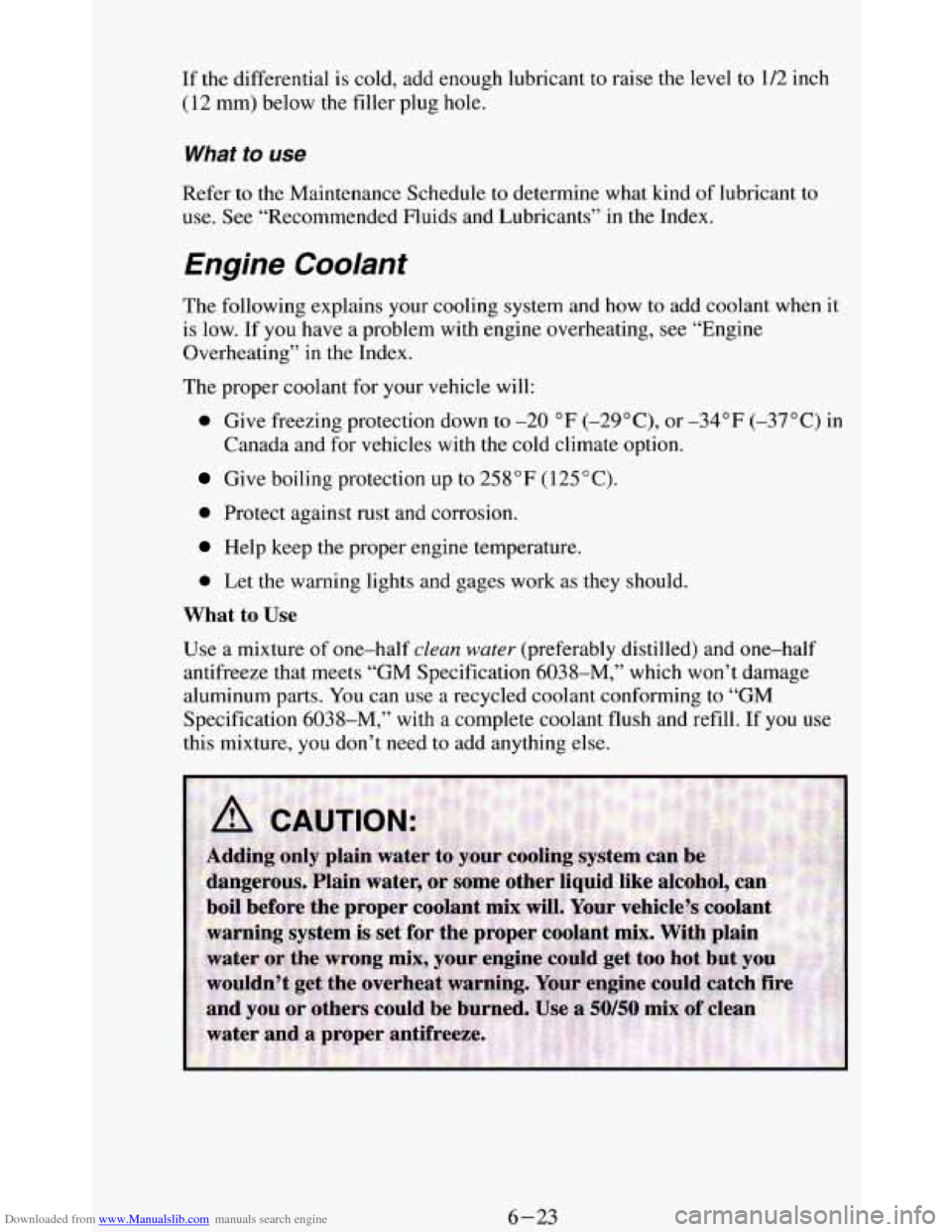
Downloaded from www.Manualslib.com manuals search engine If the differential is cold, add enough lubricant to raise the level to 1/2 inch
(12 mm) below the filler plug hole.
What to use
Refer to the Maintenance Schedule to determine what kind of lubricant to
use.
See “Recommended Fluids and Lubricants” in the Index.
Engine Coolanr
The following explains your cooling system and how to add coolant when it
is
low. If you have a problem with engine overheating, see “Engine
Overheating” in the Index.
The proper coolant for your vehicle will:
0 Give freezing protection down to -20 “F (-29”C), or -34°F (-37°C) in
Give boiling protection up to 258°F (125°C).
Canada
and for
vehicles with the cold climate option.
0 Protect against rust and corrosion.
Help keep the proper engine temperature.
0 Let the warning lights and gages work as they should.
What to Use
Use a mixture of one-half clean water (preferably distilled) and one-half
antifreeze that meets “GM Specification 6038-M,” which won’t damage
aluminum parts.
You can use a recycled coolant conforming to “GM
Specification 6038-M,” with a complete coolant flush and refill. If you use
this mixture, you don’t need to add anything else.
6-23
Page 262 of 348
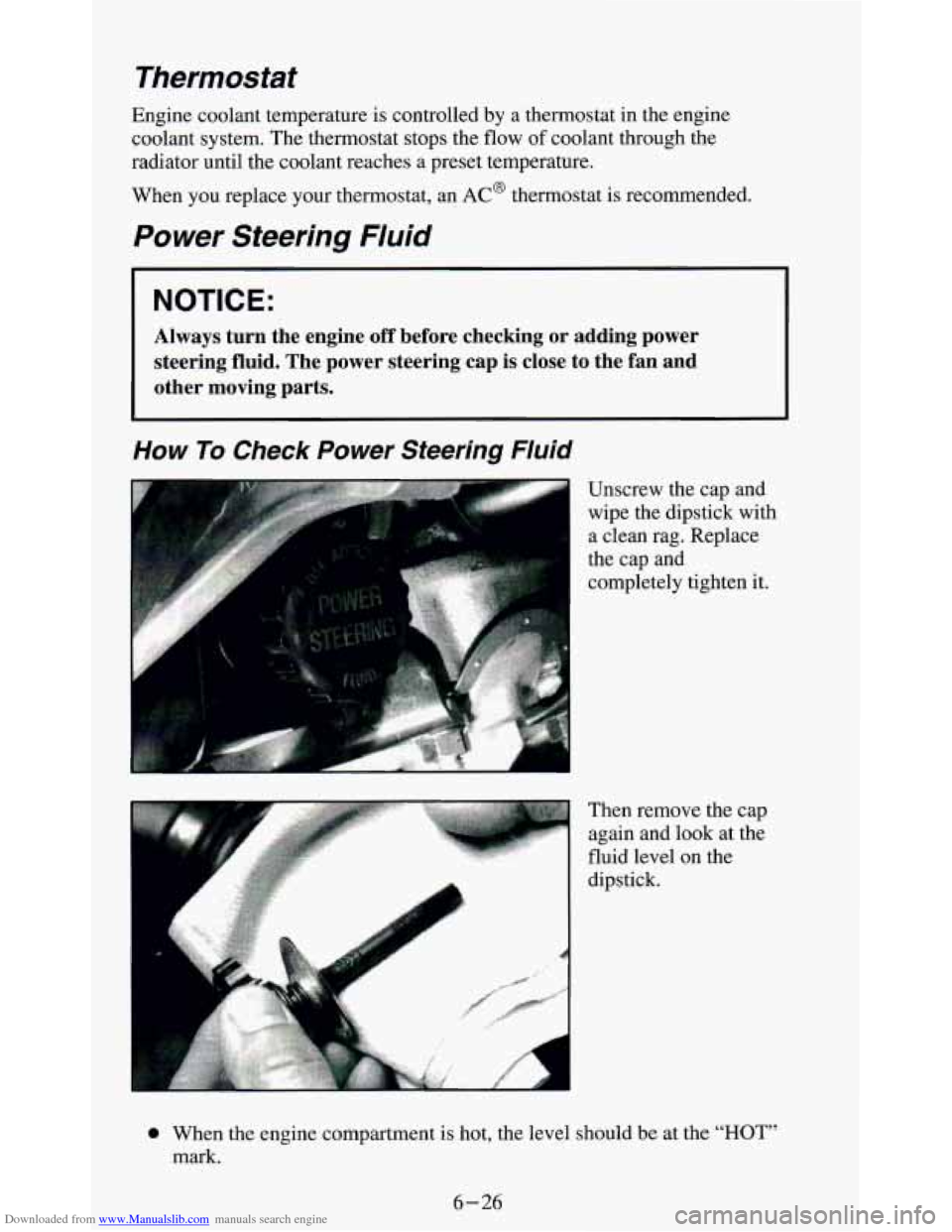
Downloaded from www.Manualslib.com manuals search engine Thermostat
Engine coolant temperature is controlled by a thermostat in the engine
coolant system. The thermostat stops the flow
of coolant through the
radiator until the coolant reaches
a preset temperature.
When you replace your thermostat, an
AC@ thermostat is recommended.
Power Steering Fluid
NOTICE:
Always turn the engine off before checking or adding power
steering fluid. The power steering cap is close to the fan and
other moving parts.
P
i
Unscrew the cap and
wipe the dipstick with
a clean rag. Replace
the cap and
completely tighten it.
Then remove the cap
again and look at the
fluid level on the
dipstick.
0 When the engine compartment is hot, the level should be at the “HOT”
mark.
6-26
Page 313 of 348
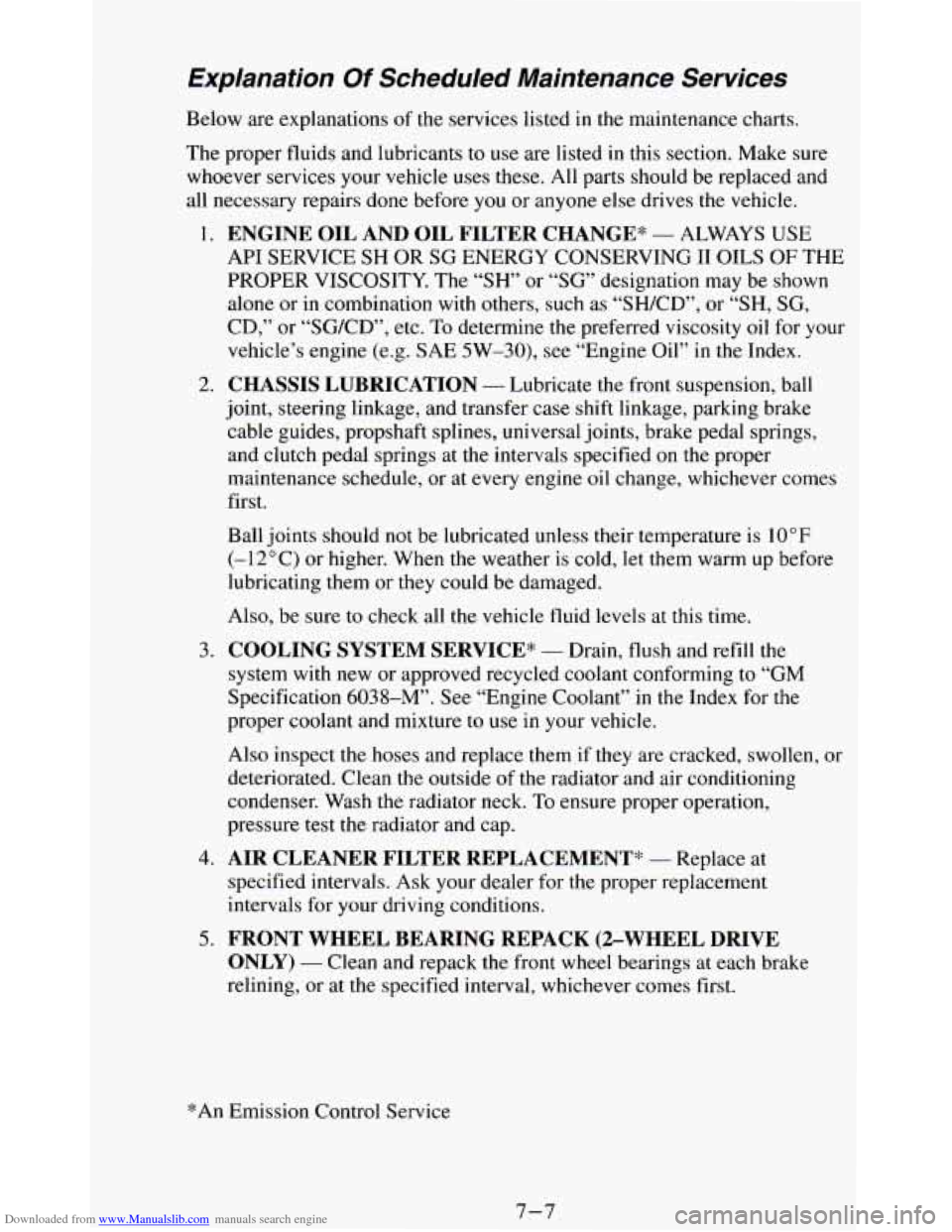
Downloaded from www.Manualslib.com manuals search engine Explanation Of Scheduled Maintenance Services
Below are explanations of the services listed in the maintenance charts.
The proper fluids and lubricants to use are listed in this section. Make sure
whoever services your vehicle
uses these. All parts should be replaced and
all necessary repairs done before you or anyone else drives the vehicle.
1.
2.
3.
4.
5.
ENGINE OIL AND OIL FILTER CHANGE* - ALWAYS USE
API SERVICE SH OR SG ENERGY CONSERVING I1 OILS OF THE
PROPER VISCOSITY. The “SH” or “SG” designation may be shown
alone or in combination with others, such as “SHKD”, or
“SH, SG,
CD,” or “SG/CD”, etc.
To determine the preferred viscosity oil for your
vehicle’s engine (e.g. SAE
5W-30), see “Engine Oil” in the Index.
CHASSIS LUBRICATION - Lubricate the front suspension, ball
joint, steering linkage, and transfer case shift linkage, parking brake
cable guides, propshaft splines, universal joints, brake pedal springs,
and clutch pedal springs at the intervals specified on the proper
maintenance schedule, or at every engine oil change, whichever comes
first.
Ball joints should
not be lubricated unless their temperature is 10°F
(-12°C) or higher. When the weather is cold, let them warm up before
lubricating them
or they could be damaged.
Also, be sure to check all the vehicle fluid levels at this time.
COOLING SYSTEM SERVICE* - Drain, flush and refill the
system with new or approved recycled coolant conforming to “GM
Specification
603%”’. See “Engine Coolant” in the Index for the
proper coolant and mixture to use in your vehicle.
Also inspect
the hoses and replace them if they are cracked, swollen, or
deteriorated. Clean the outside of the radiator and air conditioning
condenser. Wash the radiator neck. To ensure proper operation,
pressure test the radiator and cap.
AIR CLEANER FILTER REPLACEMENT” - Replace at
specified intervals. Ask your dealer for the proper replacement
intervals for your driving conditions.
FRONT WHEEL BEARING REPACK (2-WHEEL DRIVE
ONLY) - Clean and repack the front wheel bearings at each brake
relining,
or at the specified interval, whichever comes first.
*An Emission Control Service
7-7
Page 339 of 348
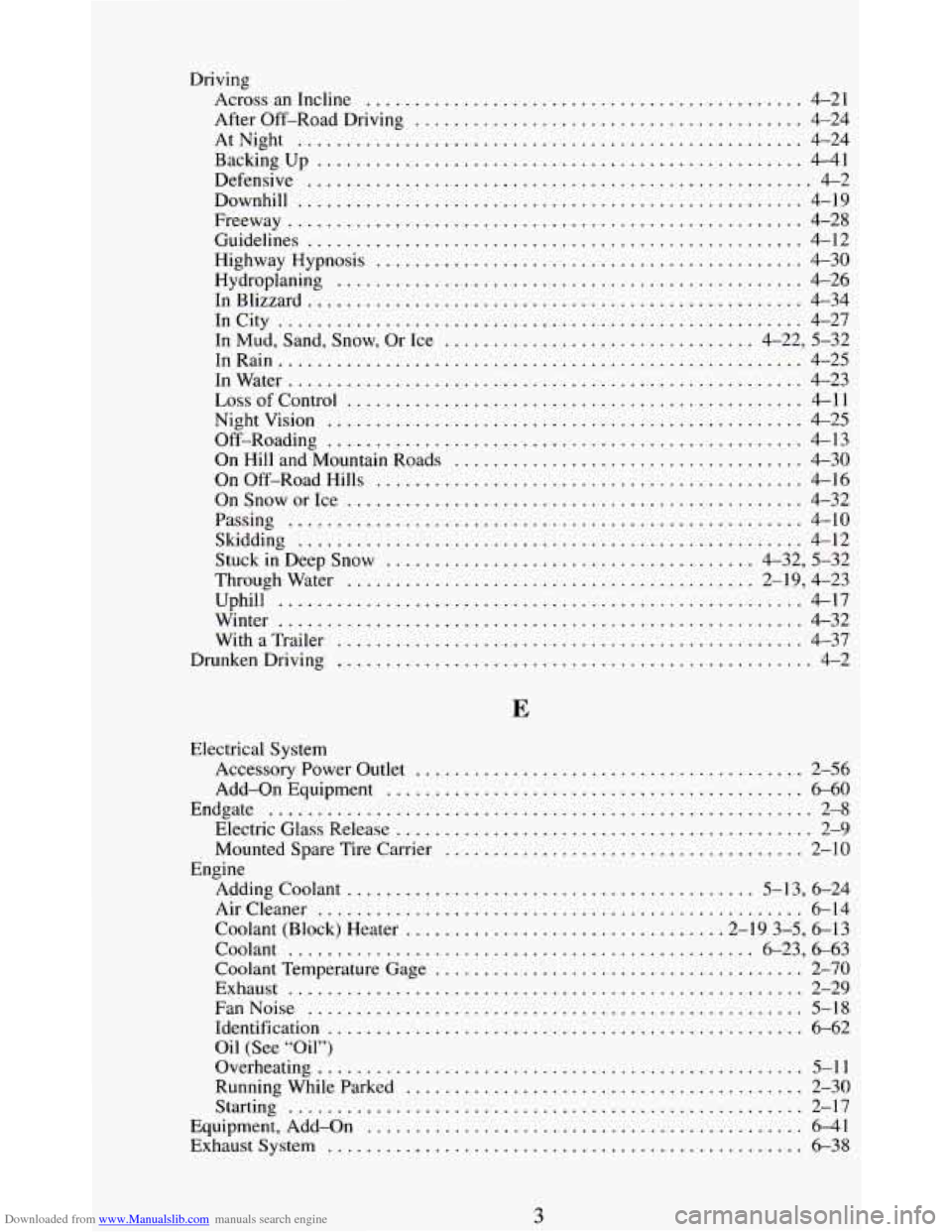
Downloaded from www.Manualslib.com manuals search engine Driving Across an Incline
............................................. 4-21
After Off-Road Driving
........................................ 4-24
AtNight
.................................................... 4-24
BackingUp
.................................................. 4-41
Defensive
.................................................... 4-2
Downhill
.................................................... 4-19
Freeway
..................................................... 4-28
Guidelines
................................................... 4-12
Highway Hypnosis
............................................ 4-30
Hydroplaning
................................................ 4-26
InBlizzard
................................................... 4-34
InCity
...................................................... 4-27
In Mud. Sand. Snow. Or Ice
................................ 4-22. 5-32
InRain
...................................................... 4-25
InWater
..................................................... 4-23
LossofControl
............................................... 4-11
Nightvision
................................................. 4-25
Off-Roading
................................................. 4-13
On Hill and Mountain Roads
.................................... 4-30
On Off-Road Hills
............................................ 4-16
OnSnoworIce
............................................... 4-32
Passing
..................................................... 4-10
Skidding
.................................................... 4-12
Stuck
in Deep Snow ...................................... 4-32. 5-32
Throughwater
.......................................... 2-19. 4-23
Uphill
...................................................... 4-17
Winter
...................................................... 4-32
With
a Trailer ................................................ 4-37
DrunkenDriving
................................................. 4-2
Electrical System Accessory Power Outlet
........................................ 2-56
Add-on Equipment
........................................... 6-60
Endgate ........................................................ 2-8
Electric Glass Release ........................................... 2-9
Mounted Spare Tire Carrier
..................................... 2-10
Adding Coolant
.......................................... 5-1 3. 6-24
Aircleaner
.................................................. 6-14
Coolant (Block) Heater
................................. 2-19 3.5, 6-13
Coolant
................................................ 6-23. 6-63
Coolant Temperature Gage
...................................... 2-70
Exhaust ..................................................... 2-29
FanNoise
................................................... 5-18
Identification
................................................. 6-62
Oil (See “Oil”)
Overheating
.................................................. 5-11
RunningWhileParked
......................................... 2-30
Starting
..................................................... 2-17
Equipment, Add-on ............................................. 6-41
Exhaustsystem ................................................. 6-38
Engine
3
Page 340 of 348
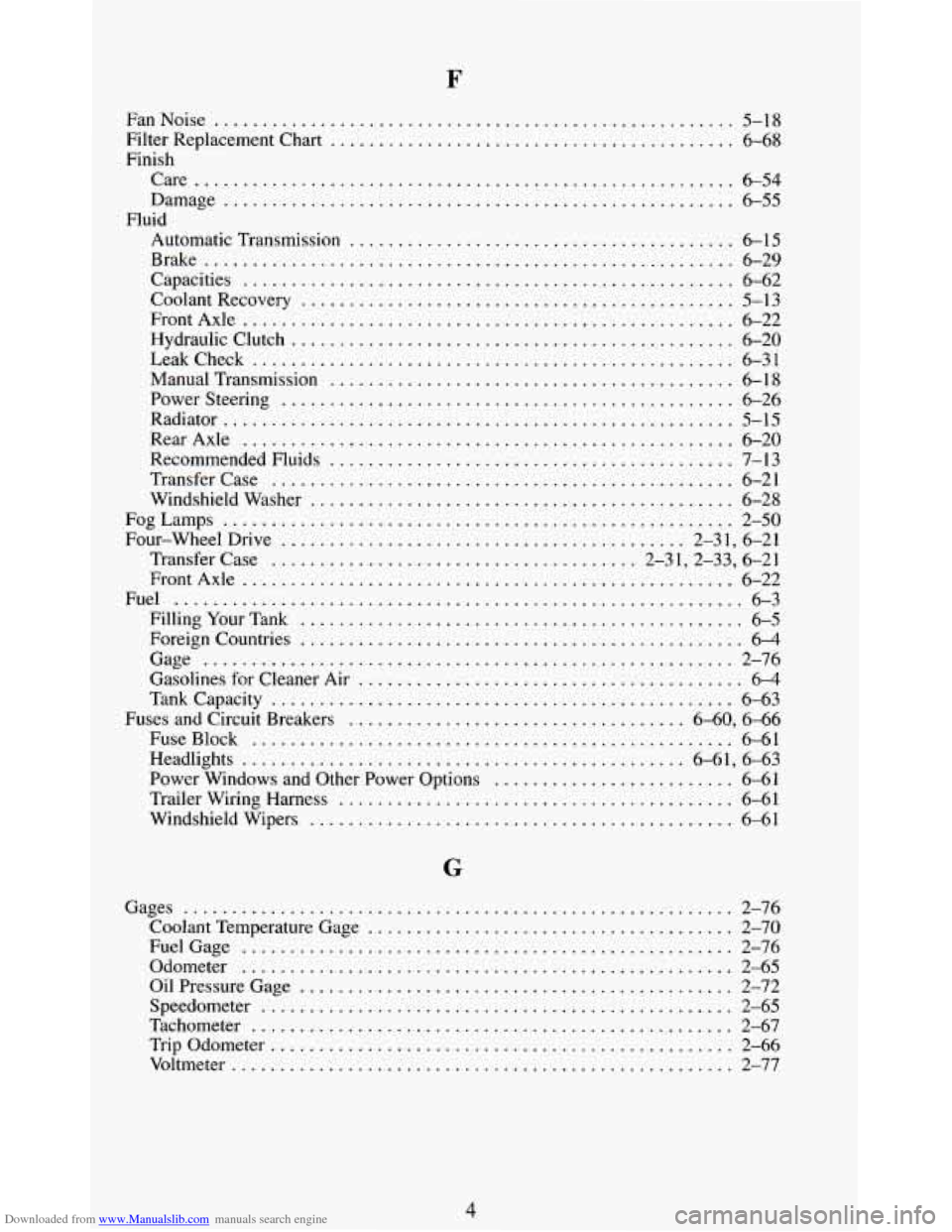
Downloaded from www.Manualslib.com manuals search engine FanNoise ...................................................... 5-18
Finish
Filter
Replacement Chart
.......................................... 6-68
Care
........................................................ 6-54
Damage ..................................................... 6-55
Automatic Transmission
........................................ 6-15
Brake
....................................................... 6-29
Capacities
................................................... 6-62
CoolantRecovery
............................................. 5-13
FrontAxle
................................................... 6-22
Leakcheck
.................................................. 6-31
ManualTransmission
.......................................... 6-18
Powersteering
............................................... 6-26
Radiator
..................................................... 5-15
RearAxle
................................................... 6-20
Recommended Fluids
.......................................... 7-13
Transfercase
................................................ 6-21
Windshield Washer ............................................ 6-28
FogLamps
..................................................... 2-50
Four-WheelDrive
.......................................... 2-31, 6-21
Transfer Case
...................................... 2-3 1,2-33, 6-21
FrontAxle
................................................... 6-22
Fuel
........................................................... 6-3
FillingYourTank
.............................................. 6-5
Fluid
Hydraulicclutch
.............................................. 6-20
Foreign Countries
.............................................. 6-4
Gage
....................................................... 2-76
Gasolines for Cleaner Air
........................................ 6-4
Tankcapacity
................................................ 6-63
Fuses and Circuit Breakers
................................... 6-60, 6-66
FuseBlock
.................................................. 6-61
Headlights
.............................................. 6-61, 6-63
Power Windows and Other Power Options
......................... 6-61
Trailer Wiring Harness
......................................... 6-61
Windshield Wipers
............................................ 6-61
Gages
......................................................... 2-76
FuelGage
................................................... 2-76
Odometer ................................................... 2-65
OilPressureGage
............................................. 2-72
Speedometer
................................................. 2-65
Tachometer
.................................................. 2-67
Trip Odometer
................................................ 2-66
Voltmeter
.................................................... 2-77
Coolant Temperature Gage ...................................... 2-70
4